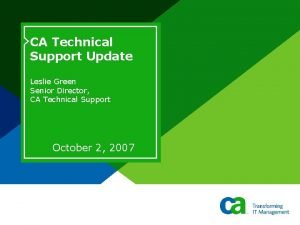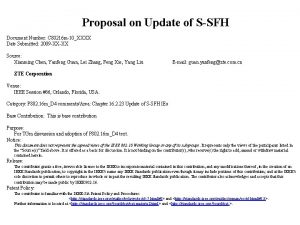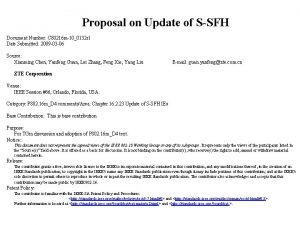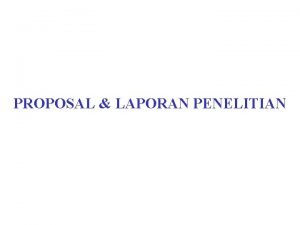Proposal on Update of SSFH 16 2 23






- Slides: 6

Proposal on Update of S-SFH (16. 2. 23) Document Number: C 80216 m-10_0132 r 2 Date Submitted: 2009 -03 -06 Source: Xianming Chen, Yanfeng Guan, Lei Zhang, Feng Xie, Yang Liu ZTE Corporation E-mail: guan. yanfeng@zte. com. cn Chun-Yuan Chiu, Yan-Xiu Zheng, Frank Ren ITRI Venue: IEEE Session #66, Orlando, Florida, USA. Category: P 802. 16 m_D 4 comments/Area: Chapter 16. 2. 23 Update of S-SFH IEs Base Contribution: This is base contribution Purpose: For TGm discussion and adoption of P 802. 16 m_D 4 text. Notice: This document does not represent the agreed views of the IEEE 802. 16 Working Group or any of its subgroups. It represents only the views of the participants listed in the “Source(s)” field above. It is offered as a basis for discussion. It is not binding on the contributor(s), who reserve(s) the right to add, amend or withdraw material contained herein. Release: The contributor grants a free, irrevocable license to the IEEE to incorporate material contained in this contribution, and any modifications thereof, in the creation of an IEEE Standards publication; to copyright in the IEEE’s name any IEEE Standards publication even though it may include portions of this contribution; and at the IEEE’s sole discretion to permit others to reproduce in whole or in part the resulting IEEE Standards publication. The contributor also acknowledges and accepts that this contribution may be made public by IEEE 802. 16. Patent Policy: The contributor is familiar with the IEEE-SA Patent Policy and Procedures: <http: //standards. ieee. org/guides/bylaws/sect 6 -7. html#6> and <http: //standards. ieee. org/guides/opman/sect 6. html#6. 3>. Further information is located at <http: //standards. ieee. org/board/pat-material. html> and <http: //standards. ieee. org/board/pat >.

Issue Introduction • When the system information is changed, it is generally desirable for the active AMSs to acquire and apply updated system parameters as soon as possible, for the purpose of the improvement of current system bandwidth utilization or network coverage. • However, the time interval for update may be long, if S-SFH SPx scheduling periodicity is set based on a longer interval, i. e. 160 ms or 320 ms, and if transmission times (i. e. 4) of each changed S-SFH SP before taking effect is guaranteed. • Besides, within the equivalent time interval beginning from SP change superframe, the probability of decoding correctly of the S-SFH SP with long scheduling period is much smaller than that of the S-SFH SP with short scheduling period. • This can cause that the active AMSs can not receive and apply updated system information in a timely fashion.

Proposed Solution • During the update process, the update method is the same for each SP. – ABS may adjust the scheduling period for each SP, and it can equal the minimal SP scheduling period supported by ABS, such as current SP 1 scheduling period. – After the updated SP has taken effect, ABS can restore the adjusted SP scheduling period to the original value before the update process. • For example: Assuming that SP 1 scheduling periodicity is 40 ms (2 superframes), SP 2 scheduling periodicity is 80 ms (4 superframes), SP 3 scheduling periodicity is 160 ms (8 superframes), and the changed SP is transmitted four times before it taking effect. Then, SP 1, SP 2 and SP 3 need 160 ms (8 superframes), 320 ms (16 superframes) and 640 ms (32 superframes) before the changing taken effect respectively. By decreasing SP 2 or SP 3 scheduling periodicity, SP 2 needs much less than 320 ms (16 superframes) before the changing taken effect, and SP 3 needs much less than 640 ms (32 superframes) before the changing taken effect.

Advantage • This method ensures that an active AMS can acquire and apply the up-to-date system information as soon as possible, and the SPs with different period may have a little difference of decoding probability for an AMS.

Figure for Solution This figure above gives one case that ABS decreases SP 3 scheduling periodicity during SP 3 update.

Proposed Text • Add the new text in page 336, line 56 in section 16. 2. 23 During SP 2 and/or SP 3 update period, the ABS transmits changed SP 2 or SP 3 in superframes only carrying P-SFH, or adjusts the SP 2 or SP 3 scheduling periodicity to a smaller value supported by ABS depending on the system configuration, When the new SP 2 or SP 3 information is applied, the ABS can restore the adjusted SP scheduling periodicity to the original period. If the failure times of decoding the P-SFH or S-SFH are more than Maximum_Retry_Time, AMS will perform reentry process.











